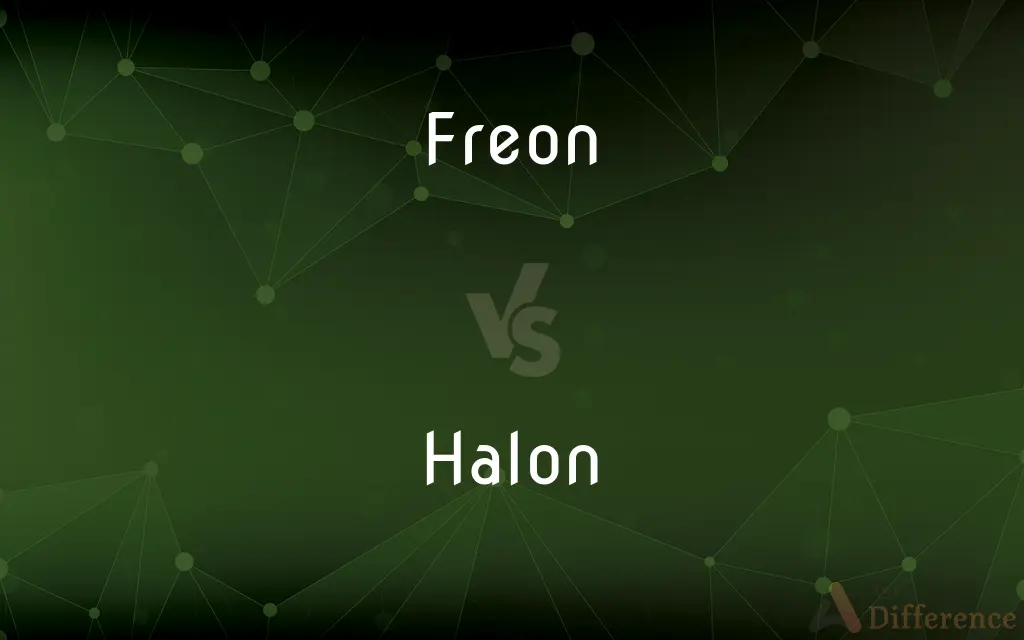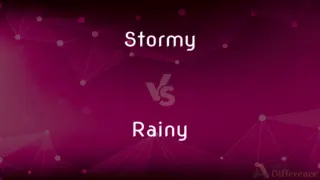Freon vs. Halon — What's the Difference?
Edited by Tayyaba Rehman — By Fiza Rafique — Updated on March 13, 2024
Freon is a refrigerant used in cooling systems; Halon is a fire suppressant used in extinguishing fires without leaving residue.

Difference Between Freon and Halon
Table of Contents
ADVERTISEMENT
Key Differences
Freon refers to a class of chlorofluorocarbons (CFCs) used primarily as refrigerants in air conditioning and refrigeration systems. These compounds were widely used due to their stability, non-toxicity, and effectiveness in heat exchange. However, their impact on ozone depletion led to significant phase-out under international agreements. On the other hand, Halon denotes a group of brominated hydrocarbons utilized in fire suppression systems, particularly in spaces where water or foam damage must be avoided, like in aircraft, data centers, and archives. Similar to Freons, Halons have been largely phased out due to their ozone-depleting properties.
Freon operates by absorbing and releasing heat through phase changes in cooling cycles, making it ideal for temperature control in various applications. Despite its efficiency, the environmental impact of Freon, specifically its contribution to ozone layer depletion and global warming, has prompted the development and adoption of alternative refrigerants with lower environmental risks. Conversely, Halon extinguishes fires by interrupting the chemical reactions occurring in a fire, a property that made it highly effective for quickly suppressing fires without damaging sensitive equipment or documents. Like Freon, the environmental concerns over Halon's ozone-depleting effects have led to restrictions on its use and the search for sustainable alternatives.
The use of Freon in new equipment has been largely discontinued, with existing systems being retrofitted or replaced to use more environmentally friendly refrigerants. This shift reflects global efforts to reduce the use of ozone-depleting substances and mitigate climate change. In contrast, while the use of Halon has also been restricted, it remains in limited use in specific critical applications where alternatives do not offer the same level of effectiveness. Efforts continue to manage existing Halon reserves responsibly and develop effective, environmentally safe fire suppression technologies.
In terms of safety, both Freon and Halon are considered low in toxicity for humans under normal exposure conditions. However, their release into the environment poses significant ecological risks, particularly to the ozone layer. This has resulted in stringent regulations governing their use, disposal, and handling. The transition away from Freon and Halon to more sustainable substances is part of broader environmental protection measures.
The phase-out of both Freon and Halon under the Montreal Protocol and subsequent amendments demonstrates the international community's commitment to protecting the ozone layer and addressing climate change. The protocol has facilitated the development of alternative substances and technologies for refrigeration and fire suppression that are less harmful to the environment, ensuring both human safety and ecological preservation.
ADVERTISEMENT
Comparison Chart
Primary Use
Refrigeration and air conditioning
Fire suppression
Environmental Impact
Ozone depletion, global warming potential
Ozone depletion, lesser global warming potential
Phase Change
Used in cooling cycles
Not applicable
Chemical Interruption
Not applicable
Interrupts fire's chemical reaction
Phase-Out
Under Montreal Protocol, alternatives sought
Limited use, with alternatives being developed
Compare with Definitions
Freon
A class of CFCs used as refrigerants.
Freon is used in air conditioners and refrigerators.
Halon
Brominated hydrocarbons used in fire suppression.
Halon systems are installed in computer data centers for fire protection.
Freon
Being replaced by more eco-friendly refrigerants.
Hydrofluorocarbons (HFCs) are used as alternatives to Freon.
Halon
Extinguishes fires by chemical interruption.
Halon disrupts the chemical reaction of a fire, quickly suppressing it.
Freon
Subject to phase-out under international agreements.
The Montreal Protocol mandates the reduction of Freon use.
Halon
Harms the ozone layer but with a lesser global warming potential than some alternatives.
Despite its effectiveness, Halon's production and use are highly controlled.
Freon
Absorbs and releases heat in cooling cycles.
Freon transitions between liquid and gas states in refrigeration systems.
Halon
Development of safer fire suppression methods is ongoing.
Inert gas systems and fluorinated gases are alternatives to Halon.
Freon
Contributes to ozone layer depletion.
The use of Freon has been restricted due to environmental concerns.
Halon
Its use is restricted to critical areas.
Halon is reserved for essential uses where alternatives are not viable.
Freon
Freon ( FREE-on) is a registered trademark of The Chemours Company, which uses it for a number of halocarbon products. They are stable, nonflammable, low toxicity gases or liquids which have generally been used as refrigerants and as aerosol propellants.
Halon
Any of several halocarbons used as fire-extinguishing agents.
Freon
(organic compound) Any of several non-flammable refrigerants based on halogenated hydrocarbon including R-12, R-22, and R-23.
Halon
(organic chemistry) A hydrocarbon (more precisely haloalkane) in which one or more hydrogen atoms have been replaced by halogens
Freon
A gaseous ozone-depleting refrigerant
Halon
A compound in which the hydrogen atoms of a hydrocarbon have been replaced by bromine and other halogen atoms; very stable; used in fire extinguishers although it is thought to release bromine that depletes the ozone layer
Freon
A chlorofluorocarbon
Common Curiosities
How does Halon work to extinguish fires?
Halon extinguishes fires by chemically interrupting the combustion process.
What is Freon used for?
Freon is primarily used as a refrigerant in air conditioning and refrigeration systems.
Why are Freon and Halon being phased out?
Both are being phased out due to their harmful effects on the ozone layer and contributions to climate change.
Can Freon and Halon still be used?
Their use is heavily restricted, with efforts to replace them with more environmentally friendly alternatives.
What are some alternatives to Freon and Halon?
Alternatives include hydrofluorocarbons (HFCs) for Freon and inert gas systems or fluorinated gases for Halon.
Is it illegal to possess or use Freon and Halon?
While not outright illegal, their use is highly regulated, with specific allowances for existing systems and critical applications.
How do environmental regulations affect the use of Freon and Halon?
Regulations like the Montreal Protocol mandate the reduction and eventual elimination of their use to protect the environment.
Are Freon and Halon toxic to humans?
They are considered low in toxicity under normal exposure conditions but pose significant ecological risks.
What industries are most affected by the phase-out of Freon and Halon?
The refrigeration, air conditioning, and fire suppression industries are adapting to the phase-out by developing and implementing alternatives.
How effective are the alternatives to Freon and Halon?
Many alternatives offer similar functionality with reduced environmental impact, though their effectiveness can vary by application.
What role do Freon and Halon play in climate change?
Their release contributes to global warming, with Freon also having a direct ozone-depleting effect.
What impact did the Montreal Protocol have on Freon and Halon?
It significantly reduced their production and use worldwide, contributing to the recovery of the ozone layer.
Can Freon and Halon be replaced in existing systems?
Many systems can be retrofitted to use alternative substances, though it depends on the specific equipment and application.
How are Freon and Halon disposed of?
Disposal must follow environmental regulations, often involving recovery, recycling, or safe destruction to minimize ecological impact.
Share Your Discovery

Previous Comparison
Tempo vs. Allargando
Next Comparison
Stormy vs. RainyAuthor Spotlight
Written by
Fiza RafiqueFiza Rafique is a skilled content writer at AskDifference.com, where she meticulously refines and enhances written pieces. Drawing from her vast editorial expertise, Fiza ensures clarity, accuracy, and precision in every article. Passionate about language, she continually seeks to elevate the quality of content for readers worldwide.
Edited by
Tayyaba RehmanTayyaba Rehman is a distinguished writer, currently serving as a primary contributor to askdifference.com. As a researcher in semantics and etymology, Tayyaba's passion for the complexity of languages and their distinctions has found a perfect home on the platform. Tayyaba delves into the intricacies of language, distinguishing between commonly confused words and phrases, thereby providing clarity for readers worldwide.
















































